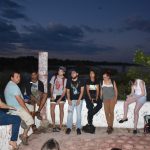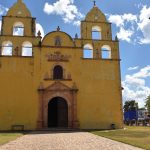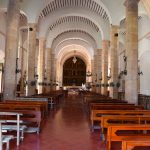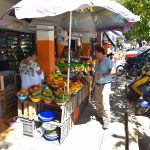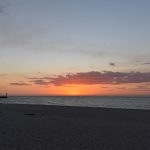Our final day in Kaxil Kiuic began early for most of us who were up to finish up some data collection for our research projects. It was here that we caught our last glimpses of the incredible biodiversity, especially in terms of bird species that this site had to offer including; Pygmy Owls, Yucatan Jays, Laughing Falcons, Hummingbirds, Yucatan Parrots and even Turkey Vultures sunning themselves at the top of Guanacaste trees. Some people who didn’t need to collect more data ventured up to the top of the observation tower to enjoy the breathtaking view before we departed for Celestún. After a productive morning we all converged for breakfast at around 8 am where we enjoyed our last meal at the reserve, signed the guest book, and had our final talk from James discussing all that we had learned and the importance of reserves such a Kaxil Kiuic not just in Mexico but globally as well. As new friends of Kaxil Kiuic we boarded the bus and departed for Celestún.
After about an hour on the bus we arrived in the Mayan town of Oxkutzcab (In Mayan – “The Place of Ramon, Tobacco and Honey”), where we stopped to look through a traditional Mayan market that had been happening in this area for many years. At the market there were tons of fresh produce vendors, jewelery stalls, and traditional Mayan clothing vendors to name a few. While enjoying popsicles and ice cream in the central square we compared purchases, people bought rope bracelets, earrings, and even some hammocks.
As we approached Celestún along the gulf we started seeing the mangroves appear, a few people even spotted some flamingoes on the way in. Upon our arrival we were greeted with a beautiful ocean view and a seafood feast for lunch! After lunch we took a quick dip in the ocean before we headed about 5 minutes outside of Celestún to get our first up close look at the mangroves. Once we got to the mangroves, Javier and Dr. Lougheed told us about the importance of their presence not just in terms of the ecology of an ecosystem but also how they have positive impacts upon human societies. Although a bit odiferous our first look at the mangroves was interesting and eye opening. Then we headed back to the hotel for dinner, and then it was off to bed to rest up for the next day of activities!
Español
Nuestro ultimo día en Kaxil-Kiuic inició temprano para la mayoría de nosotros con la idea de colectar más datos para nuestros proyectos. Tuvimos la oportunidad de observar y apreciar la biodiversidad, principalmente las distintas especies de aves que se encuentran en el sitio, como el Tecolotito pigmeo, Las Charas yucatecas, Halcón selvático, colibries, Loros yucatecos y hasta zopilotes. Algunos de los equipos que ya no tenían que colectar datos se aventuraron a la torre de observación para disfrutar una vez más la incredible vista antes de nuestra partida a Celestún. Después de una productiva mañana nos juntamos como a las 8:00am para nuestro último desayuno. Luego firmamos el libro de visitas para después escuchar una última plática por James sobre la importancia de Kaxil-Kiuic no solo localmente sino hasta internacionalmente. Nombrados como nuevos amigos de Kaxil-Kiuic, abordamos el autobus con rumbo a Celestún.
Después de aproximadamente una hora de viaje, paramos en Oxkutzcab, un pueblo maya donde apreciamos las tradiciones locales en el Mercado maya local, con costumbres que datan desde hace 500 años. Encontramos muchos vendedores de productos agrícolas frescos, puestos de ropa y de joyería comercial. Mientras disfrutamos también de unas ricas paletas de hielo y helado en la plaza, comparabamos nuestras compras, incluyendo pulseras de hilo, arêtes y hasta hamacas.
Estando yam ás cerca de Celestún, apreciamos ya la presencia de manglares y hasta alguien vió flamencos a la llegada. Fuimos recibidos por una vista espectacular del mar y un buffete de comida con mariscos. Despúes de comer nos fuimos a dar un chapuzón al mar antes de salir nuevamente para nuestra primera visita a un manglar. Ya que llegamos, Javier y Dr. Lougheed nos inform de la importancia de los manglares no solo por sus funciones ecológicas como ecosistema, sino también por el impacto positive para los asentamientos humanos. Aunque con el olor sulfuroso, nuestro primer acercamiento a los manglares fue interesante y muy ilustrativo. Terminando, regresamos al hotel para cenar y después descansar para prepararnos para las acividades del día siguiente.
